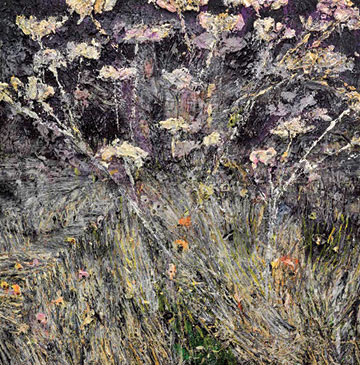Der Morgenthau Plan
by J. Tim Raymond


The Albright Knox’s newly purchased Anselm Kiefer painting goes on display on November 17
Truman was not much impressed by the staff he inherited from FDR. “Most of the people Roosevelt had close around him were crackpots and the lunatic fringe,” he told an aide. He was alluding to, among others, Henry Morgenthau, secretary of the treasury during the brief third term of the Roosevelt administration.
The quote is from the 1976 “tell-all” book about the national mood and administrative policy making in the United States from 1945 to 1950, The Best Years by Joseph Goulden. A mere mention buried in a smallish paragraph, but behind it lays a story of considerable social, political, and psychological intrigue involving the end of World War II and the US plans for a defeated Germany.
Not inconsequently the title of one such plan, “The Morgenthau Plan,” is also the title of a major new painting by the German artist Anselm Kiefer, recently purchased by the Albright-Knox Art Gallery by the new gallery director Janne Siren. The Kiefer painting on view is part of a year-long exhibition opening November 17th. Siren says the painting was an ideal “bookend” to the earlier museum purchase in 1988 of the equally large-scale Kiefer work, Die Milchstrasse. Kiefer’s artworks are bravura, massive, mixed-media behemoths—materially and emotionally layered wall-sized slabs overarching with underpinnings of deep, psychological rumblings, unsettling and mesmerizing in their illusive and paradoxical complexity.
Born in 1945 at the edge of the Black Forest in the closing weeks of World War II, Kiefer grew up in the ravaged post-war landscape. Later, as a reluctant law student, he vacillated between painting and writing. A short period spend in study with artist Joseph Beuys, whose work as a performance artist dealt with Germany’s recent martial past, convinced Kiefer to make art, provoking ideological, spiritual, and psychological investigations.
Over time he developed his themes, plumbing issues of wartime trauma and calumny. The previous “bookend” piece, Die Milchstrasse (The Milky Way), is a landscape depicting a scene of scorched earth in acute perspective with a strict horizon line, a massive, wall-filling, photo-based image in a palimpsest of metaphysical alchemical allusions. One particular appalling interpretation had to do with the bright white slice in the middle of the piece, paint ostensibly representing the glow of creative redemption piercing through the burned and furrowed fields, but also taken to mean the profane realities of atrocity, the slang term of the concentration camp guards for the trenches of white lime used to speed the decomposition of victims. In one survivor’s shuddering recollection, the ground was so filled with gases escaping from the bodies that the earth visibly appeared to belch.
The Morgenthau Plan was proposed in 1944, and conceived to transform post-war Germany into a pre-industrial agricultural nation annexing or dismantling German centers of industry. It was a particularly vindictive program to de-industrialize and diminish the German people to a pastoral existence, allegedly in order to limit the country’s ability to wage war. Officially known as the “Treasury Plan for the Treatment of Germany” it would have led to death by starving and disease of 10 million Germans in the two years following World War II, in addition to the one million already killed in the systematic strategic bombing of Germany and three million killed in the enforced expulsion of Germany’s eastern territories. At the time, FDR was on board with Morgenthau, saying, “Let them live off soup kitchens” and “Make sure there’s no more uniforms and marching.” Despite his re-election FDR was in the waning months of cognitive coherence and, along with Winston Churchill (“Shoot German officers on site”), did not invest the critical thinking skills to recognize in their innocence of higher economies and the mysteries of international finance the impulsiveness and lack of systematic study that would produce results worse than all the guilt of the Nazi Reich.
When, in September 1944, the Wall Street Journal published the details of the Morgenthau Plan, FDR immediately tried to distance the administration from it. James Forrestal, the secretary of defense, said the American people would not support the enslavement or industrial devastation of Germany. After the death of Roosevelt in April 1945, Morgenthau continued to push his punitive proposal, but Truman, having ascended to the presidency, wanted no part of another “Sherman’s march to the sea.”
The alternative, known as the “Marshall Plan,” after General George C. Marshall, and later the “Truman Doctrine,” were put into place and worked as intended, giving Germany rights to re-build and maintain an industrial economy. Sensing a vast peacetime responsibility for world security, the two administrative enterprises together meant the US would from that day forward use dollars and armed force to contain the threat of Communism—indeed, partnering with right-wing governments if necessary.
Kiefer’s painting dwells subcutaneously on the flaws of reasoning that promoted the overriding personal resentment, moral righteousness, and national superiority that engendered the Morgenthau Plan. It depicts a field of wildflowers in close-up thick impasto, completely obscuring the original photograph beneath. The artist sees the plan as a metaphor for the common pitfall of the creative process, “that puts forth beauty without any other detectable motive.” He presents the shortsighted, meanspirited initiative as a representation of ideas—artistic and political—that ignore “the complexity of things.”
Along with Gerhard Richter, the writers Heinrich Boll and Gunther Grass, and the filmmaker Ranier Werner Fassbinder, Anselm Kiefer’s artwork sheds excoriating light on Germany and now America’s double legacy of culture and barbarism.
blog comments powered by Disqus|
Issue Navigation> Issue Index > v12n36 (Week of Thursday, September 5) > Der Morgenthau Plan This Week's Issue • Artvoice Daily • Artvoice TV • Events Calendar • Classifieds |









 Current Issue
Current Issue